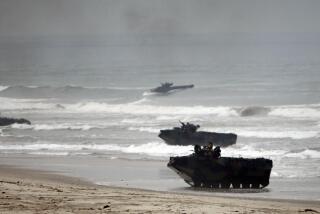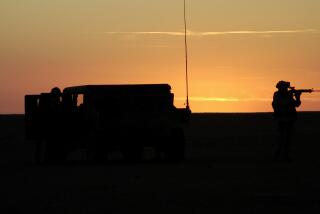New Breed Carries On : The Hallowed 1st Marine Division Reflects a Changing Corps
The 1st Marine Division from Camp Pendleton, steeped in the history of three wars, is taking its reputation into the massive ground battle against entrenched Iraqi troops.
This force of roughly 20,000 ground-combat Marines, better educated and more highly trained than earlier generations of Marines, brings its own brand of fast-moving, hard-hitting tactics against the enemy.
After a dark era for the military that included the crucible of Vietnam, the 1st Marine Division is eager to replay the role that made the Corps famous--at Guadalcanal in World War II and at Inchon during the Korean War.
“They’re going to show they can carve out some history that’s as colorful and dynamic in this 1991 division as the 1941 division,” said retired Marine Corps Maj. Gen. Marc Moore, who served with the division in Vietnam.
The 1st Division--with its own infantry, tanks, artillery, reconnaissance and amphibious elements--is a largely self-contained force that Moore expects will cut off entrenched front-line Iraqis and move against the elite Republican Guard.
“I think it’s going to be very swift, no frontal attrition. It will surprise a lot of folks what they can do,” said Moore. “The main battle will be in the rear with the Republican Guard.”
Unlike its bigger and more heavily equipped Army counterparts, the Marines are accompanied by lighter weapons, allowing them to be more deft and to specialize in thrusts to test the enemy, discover weak spots and rush in quickly.
And, although the 1st Division does have air and logistic support, the greatest danger would be to become overextended, to penetrate too far and chance getting cut off, military officials say.
“There is an element of risk, absolutely,” said Maj. Mark Thiffault, a Camp Pendleton spokesman and a Vietnam veteran.
However, he said, “We come with our own air force, artillery and support. We are a much more potent fighting force. . . . We have the firepower to stay with the campaign.”
Staying power is what earned the 1st Division--the most decorated and oldest outfit of its size--its place in Marine legend.
“It’s a fraternity that’s very strong,” said Col. Robert Tilley, who served in three command positions within the division and now, as he holds an administrative post at Camp Pendleton, is frustrated that he can’t rejoin his old outfit in battle.
He recalled a recent gathering of the 1st Marine Division Assn., which was formed in 1947 and now has 14,000 members nationwide, including 2,275 in California. “I met guys from World War I, they fought in 1917. Here they are, exchanging all this brotherhood.”
What has bound the Marines to each other and this division began on Feb. 1, 1941, nearly a year before America’s entry into World War II, when the division was activated aboard the battleship Texas.
The division was melded from old regiments of crusty grunts in khaki and leggings who had fought in places such as Veracruz, Mexico, in 1914 and the Dominican Republic in 1916, to the grand battles in France at Belleau Wood and Chateau-Thierry during World War I.
Moore calls the 1st Division the “wellspring” of the modern Marine Corps because its lineage goes back to the early part of the century.
It became famous for its performance during the brutal campaign against tenacious Japanese for Guadalcanal, and afterward at Peleliu and Okinawa. Later, in 1950, the 1st Division landed at Inchon in Korea and survived a grueling fight out of the Chosen Reservoir, where it encountered overwhelming numbers of Red Chinese troops.
One war later, the 1st Division, dubbed “The Old Breed,” served for six years in Vietnam, including during the 1968 Tet offensive when Marines resisted the strongest all-out attack of the war, including the battle for Hue. The 1st Division returned to Camp Pendleton in early 1971.
It has shed a lot of blood and amassed incredible memories.
“The camaraderie is always there. The Semper Fi thing means the world to us, it never leaves,” said Bill Ping, who was seriously wounded at the Chosen Reservoir and is national vice president of the 1st Marine Division Assn.
Now the 1st Division has found its place in another war.
It is the ground combat arm of the I Marine Expeditionary Force, an umbrella organization that also includes aircraft units from the Marine Corps Air Stations at El Toro in Orange County, and units of tanks and amphibious vehicles from Twentynine Palms in San Bernardino County.
About 30,000 Marines and reservists left Camp Pendleton in two large deployments in August and December. Commanding the I MEF is Lt. Gen. Walter Boomer, and under him, Maj. Gen. James Myatt heads the 1st Marine Division.
Also serving under the I MEF is the 2nd Marine Division based at Camp Lejeune in North Carolina.
There are about 90,000 Marines in the war zone, about half of them attached to the expeditionary force.
While the 1st Division and the corps as a whole have their customs and traditions, there have been profound changes since Vietnam.
“I would say, with the lethality of our weapons, they are the best-trained Marines that have ever been on the face of the Earth,” said Tilley.
Emerging from the military’s painful Vietnam experience, which included domestic opposition, political restraints and America’s eventual withdrawal, the Corps found its quality somewhat diminished because it had resorted to the draft to meet wartime manpower needs.
The Corps, like other branches of the service, also experienced racial friction and drug abuse.
Russ Thurman, who saw combat with the 1st Division in Vietnam and rose through the ranks to retire as a captain, recalled how the war’s bleak aftermath discouraged many career-minded Marines. “A lot of good Marines left the service,” he said.
Slowly, the Corps has been reshaped.
It returned to being an all-volunteer force that demands that all new Marines at least hold a high school diploma. And it has improved its training. No longer is it enough to simply know how to fire sophisticated weaponry; Marines are given more instruction in maneuvering with their weapons so as to capitalize on foes’ weaknesses.
Although many Marines have such non-infantry jobs as truck driver and cook, the Corps has returned to teaching basic field tactics. Commandant Al Gray insists that all Marines be trained and retrained to think and fight like a warrior if and when the need arises.
As was vividly demonstrated in Vietnam, successful small-unit combat in the jungle required lower-ranking Marines--young lance corporals and lieutenants--to be given some discretion over field tactics. All battlefield decisions can’t be made from the top.
That lesson has been remembered, and the new Corps seeks to issue commands that give a mission’s purpose, but largely lets those in the field decide how to accomplish its goals.
“In the old Corps, there was always someone staring down your leg, telling you how to do it,” said 1st Lt. Chuck Lindberg, a training officer at Camp Pendleton. These days, “I’m going to tell you what’s important, then I’m going to set you loose to accomplish it,” all within a clearly defined operation.
And, although there’s always room for extraordinary courage in combat, the Corps emphasizes teamwork.
“If you get the Rambo syndrome--the guy who wants to do it all by himself--those guys are changed or eliminated from the team,” said Lt. Col. Ray Blum, commanding officer of the Warrior Training Battalion.
The Corps is confident.
Vietnam combat veteran Thurman said of the contemporary Marine: “His ability to close with and destroy the enemy is better than when I was a private. And we were good.”


